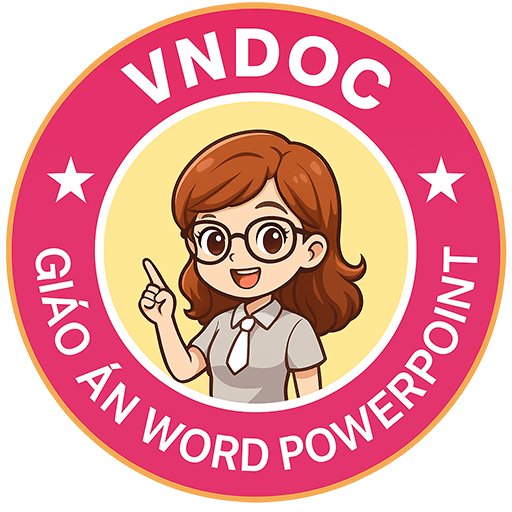Giáo án tiếng Anh lớp 12 Tuần 23 sách mới
Giáo án tiếng Anh lớp 12 chương trình mới Tuần 23
Nằm trong tài liệu Giáo án môn Tiếng Anh 12 theo tuần, giáo án Tiếng Anh Tuần 23 lớp 12 sách mới dưới đây do VnDoc.com sưu tầm và đăng tải. Giáo án tiếng Anh gồm Lesson 5 Listening, Lesson 6 Writing; Lesson 7 Cmmunication and Culture Unit 7 Artificial Intelligence giúp quý thầy cô chuẩn bị bài giảng hiệu quả.
Date of preparation: Date of Teaching:
TIẾT 67: UNIT 7. ARTIFICIAL INTELLIGENCE
LESSON 5. LISTENING
A. Aims and Objectives: - To develop Ss’ skill of listening to for specific information.
- To help Ss understand general ideas and specific details.
- By the end of the lesson, students will be able to:
+ Listen and do the tasks.
+ Develop the listening skills for specific details.
+ Identify specific information through true false task and question answering
B. Preparations: - Teacher: Handouts, textbook, pieces of papers and cassette.
- Students: Textbook
C. Methods: - The whole lesson: Integrated, mainly communicative.
D. Procedures:
|
Time/Stages |
Activities |
|
1. Lead-in 5 minutes |
Inform the class of the lesson objectives: listening for specific information in a conversation about Ray Kurzweil’s predictions about the future of A.I. |
|
2. New lesson
10 minutes
10 minutes
10 minutes
7 minutes
|
The future of A.I. Task 1: Match word in column A with its meaning in column B. - T asks Ss to work in pairs to match the words and phrases with their meanings. - T checks answers as a class. Key: 1.c 2.d 3.a 4.f 5.b 6.e Task 2: Listen to the conversation between Nam and Mai. Decide whether the following statements are true (T), false (F), or not given (NG) and tick the correct box. - This activity focuses on listening for specific information. - T asks Ss to read the sentences and underline the key words. - T plays the recording twice: the first time all the way through, and the second time pausing at appropriate places for Ss to tick the correct boxes. - T has Ss compare their answers in pairs. - T checks answers as a class. Key: 1. NG 2. F 3. F 4. T 5. T 6. T 7. T Task 3: Listen again. Answer the following questions. - T plays the recording without pausing, has Ss answer the questions individually and then compare their answers in pairs. - T checks answers as a class. Suggested answers: It is about artificial intelligence. He is an author, computer scientist, inventor, and futurist. He’s very talented. They will think quicker than humans. He called them nan-robots. Because she thinks of the tasks of the scientists: careful developing A. I. programs while also detecting any malfunctions and preventing cyber-attacks. Task 4: Work in groups to get more information about Ray Kurzweil’s ideas and report to the class. This activity is a follow-up activity which enables Ss to do some research on Ray Kurzweil. If there is not enough time, assign the activity as homework and have Ss report their research findings in the next lesson. Resource for ref. https://en.wikipedia.org/wiki/Ray_Kurzweil |
|
3. Consolidation 2 minutes |
- Ask Ss to consolidate the main contents. - Ask Ss: What have you learnt today? What can you do now? |
|
4. Homework 1 minute |
- Prepare for the next lesson. |
E. Evaluation:
......................................................................................................................................................
Date of preparation: Date of Teaching:
TIẾT 68: UNIT 7. ARTIFICIAL INTELLIGENCE
LESSON 6. WRITING
A. Aims and Objectives: - Writing an essay about the advantages and disadvantages.
- To provide Ss with the language and sentence structures used to describe trends.
- By the end of the lesson, students will be able to:
+ Writing an essay about the advantages and disadvantages of intelligent machines.
+ Develop the writing skills in general. Build up vocabulary supported for writing.
B. Preparations: - Teacher: Handouts, textbook, lesson plan and pieces of papers.
- Students: Textbook
C. Methods: - The whole lesson: Integrated, mainly communicative.
D. Procedures:
|
Time/Stages |
Activities |
|
1. Check up 5 minutes |
The lesson objective: Writing an essay about the advantages and disadvantages of intelligent machines. |
|
2. New lesson
14 minutes
8 minutes
15 minutes
|
Advantages and disadvantages of intelligent machines Task 1: Put the following phrases about intelligent robots in the appropriate columns. - To provide advantages and disadvantages of intelligent machines. - To read the sentences carefully and put them in columns. Key: Advantages: 2, 3, 6 Disadvantages: 1, 4, 5 Task 2: Read and combine the sentence halves. - This activity provides more ideas for the writing task. - T asks Ss to read and match the sentence halves individually. - T checks answers as a class. Key: 1. d 2. g 3. e 4. f 5. c 6. a 7. b Task 3: Write an essay of about 220-260 words to discuss the advantages and disadvantages of intelligent robots in industries and medicine. - The aim of this activity is to develop Ss’ writing skills - To study suggested plan, and write their drafts individually. - T asks them to compare their writing in pairs and obtain peer feedback. - T Collects some final drafts and give feedback. Helpful ideas: Introduction: robots are widely used in the food industry and medicine/ they have advantages and disadvantages Body: advantages: fewer human workers, errors, and defects disadvantages: power failure, malfunction, hackers Conclusion: help humans improve their lives a threat to humans or not? Suggested answer: A. I. robots are widely used in areas such as the food industry and medicine. Obviously, they bring advantages as well as disadvantages. The advantages of intelligent robots are countless. Robotic machines are countless. Robotic machines can replace the human workforce in industrial assembly lines because they cannot only complete tasks faster than humans, but also make fewer errors. Furthermore, unlike humans, they take no breaks. In modern manufacturing plants, one out of every ten thousand workers is a robot. That is the reason why robots are so widely used in the automobile and electronics factories. In hospitals, A. I. robots can operate on patients, and help doctors to discover damaged organs in patients. They also help experts to do research on any serious side effects caused by the interactions of different medications on patients that can lead to complications in treatment. The disadvantages of A. I. are undeniable. Robots and other robotic machines are designed and programmed by humans. Therefore, they can be attacked by malware or viruses or disabled due to power failure. In such cases, the computer systems will crash and A. I. devices will become useless machines. Another disadvantage is that the computer operating systems could be taken control of by hackers, causing misuse of robotic devices. This could potentially be dangerous to human lives. In conclusion, robots benefit humanity because the aim of their creation is replace people in stressful and dangerous jobs, and make their lives better. But relying on them completely is dangerous, because so much can go wrong with them. In the end, the advantages outweigh the disadvantages. |
|
3. Consolidation 2 minutes |
- Ask Ss to consolidate the main contents. - Ask Ss to complete the writing at home and collect - Ask Ss: What have you learnt today? What can you do now? |
|
4. Homework 1 minute |
- Write the text again at home. - Prepare for the next lesson. |
E. Evaluation:
.....................................................................................................................................................
Date of preparation: Date of Teaching:
TIẾT 69: UNIT 7. ARTIFICIAL INTELLIGENCE
LESSON 7. COMMUNICATION AND CULTURE
A. Aims and Objectives:
1. Language focus - Attitudes towards artificial intelligence in some developed countries.
2. Skills:- To develop their communication skills and cultural understanding
- To help Ss develop the skill of working in pairs and groups
3. Attitudes: - To encourage Ss to work harder. To provide Ss some motivation
- By the end of the lesson, students will be able to: Understand and communicate about communication skills and cultural understanding
B. Preparations: - Teacher: Handouts, textbook, lesson plan and pieces of papers.
- Students: Textbook
C. Methods: - The whole lesson: Integrated, mainly communicative.
D. Procedures:
|
Time/Stages |
Activities |
Interactions |
|
1. Warm up 5 minutes |
Inform the class of the lesson objectives: Further skill development. |
T <--> Ss |
|
2. New lesson
18 minutes
19 minutes
|
1. Communication: Artificial intelligence in science-fiction films Activity 1: Listen to a conversation between Linh and Nam. Circle the correct letters to complete the sentences. - The aim of this activity is to provide further listening practice of the topic of artificial intelligence in science-fiction films. - To listen to a conversation between Linh and Nam about artificial intelligence in science-fiction films. - T asks Ss to read the statements and guess. (Ref. https://en.wikipedia.org/wiki/Motion_Picture_Association_of_America_film_rating_system) - T asks Ss to compare their answers in pairs. - T checks answers as a class. Key: .1B 2.C 3.C 4.B 5.B Activity 2: Discuss and recommend an interesting film about A. I. - This follow-up activity provides Ss with further speaking practice after the listening activity. do some research or watch science-fiction (sci-fi) films about the rise of intelligent machines (Zing TV, YouTube, PhimMoi.net, etc.) - T asks some pairs to present their recommendations to the class. 2. Culture: People’s attitudes towards intelligent machines Activity 1: Read a text about people’s attitudes towards intelligent machines. Answer the questions that follow. - Objective of the activity: enriching Ss’ knowledge by reading about the different attitudes of people in developed countries towards intelligent machines. - Brainstorm what they know about popular domestic robots in use today, then asks them to give their opinions about these automated machines. - T asks Ss to read the questions and underline the key words. - T tells them to compare their answers in pairs. - T checks answers as a class. Key: To help robot designers and developers to visualise / envision the roadmap for their future development. They focus on the domestic use of robots. A lot of people think they are small domestic machines that can be controlled. A few want robots to be friends that can speak and communicate with them. People don’t want robots to llok after children or animals. Because they fear that malfunctioning robots could be harmful and dangerous, and humans might lose control over them. |
Pair work
T <--> Ss
Group work
T <--> Ss
Individually
T <--> Ss
|
|
3. Consolidation 2 minutes |
- Ask Ss to consolidate the main contents. - Ask Ss: What have you learnt today? What can you do now? |
T <--> Ss |
|
4.Homework 1 minute |
- T asks Ss to learn the structures and vocabulary. - Prepare for the next lesson. |
T <--> Ss |
E. Evaluation:
......................................................................................................................................................
Trên đây là Giáo án tuần 23 môn tiếng Anh 12 mới.
Xem thêm giáo án tiếng Anh 12 cả năm tại: Giáo án tiếng Anh 12 chương trình mới cả năm. Mời bạn đọc tham khảo thêm nhiều tài liệu ôn tập Tiếng Anh 12 khác như: Để học tốt Tiếng Anh lớp 12, Bài tập Tiếng Anh lớp 12 theo từng Unit trực tuyến, Đề thi học kì 1 lớp 12, Đề thi học kì 2 lớp 12,... được cập nhật liên tục trên VnDoc.com.





